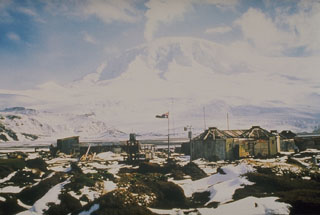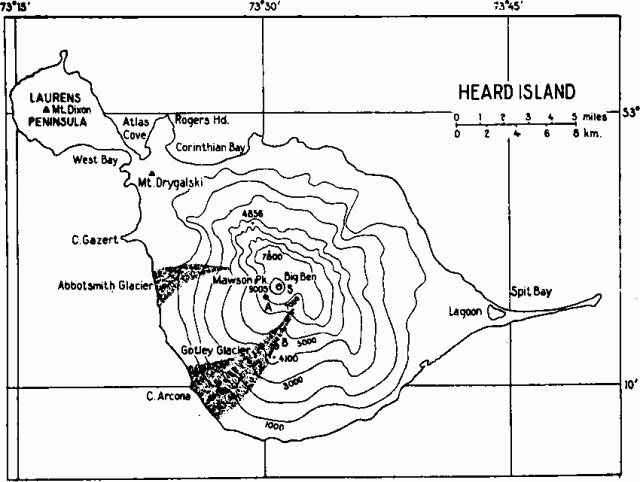Report on Heard (Australia) — February 1985
Scientific Event Alert Network Bulletin, vol. 10, no. 2 (February 1985)
Managing Editor: Lindsay McClelland.
Heard (Australia) Lava flow from upper S flank vent; plume
Please cite this report as:
Global Volcanism Program, 1985. Report on Heard (Australia) (McClelland, L., ed.). Scientific Event Alert Network Bulletin, 10:2. Smithsonian Institution. https://doi.org/10.5479/si.GVP.SEAN198502-234010
Heard
Australia
53.106°S, 73.513°E; summit elev. 2745 m
All times are local (unless otherwise noted)
During the night of 14-15 January, personnel of the French oceanographic mission Sibex (ship) observed an eruption on Heard Island. A lava flow emerged from a vent at ~ 2,750 m altitude, on the upper S flank (between Big Ben and Mawson, figure 1). For 2 days, a plume was visible from 32 km away. An image from the NOAA 7 polar orbiting satellite showed a diffuse plume extending SE from the island on 14 January at 1712. The plume was narrow over the island, widening over the ocean until obscured by weather clouds 20-25 km to the SE. The next day at 1658, NOAA 7 imagery showed that the island was free of weather clouds, but no volcanic plume was evident.
Reference. Neumann van Padang, M., 1963, Catalog of active volcanoes of the world, Part XVI.
Geological Summary. Heard Island on the Kerguelen Plateau in the southern Indian Ocean consists primarily of the emergent portion of two volcanic structures. The large glacier-covered composite basaltic-to-trachytic cone of Big Ben comprises most of the island, and the smaller Mt. Dixon lies at the NW tip of the island across a narrow isthmus. Little is known about the structure of Big Ben because of its extensive ice cover. The active Mawson Peak forms the island's high point and lies within a 5-6 km wide caldera breached to the SW side of Big Ben. Small satellitic scoria cones are mostly located on the northern coast. Several subglacial eruptions have been reported at this isolated volcano, but observations are infrequent and additional activity may have occurred.
Information Contacts: J. Bull, Terres Australes et Antarctiques Françaises; A. Giret, Expeditions Polaires Françaises; J-L. Cheminée, IPG, Paris; W. Gould, NOAA.


